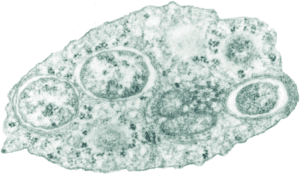

Viruses are tidily categorized into three groups according to the hosts they infect – bacteriophages, eukaryotic viruses, and archaeal viruses. Viruses do not infect hosts in another domain of life, and therefore lateral gene transfer is limited (giant DNA viruses might be exceptions). Now there is evidence for lateral gene transfer between eukaryotes and bacteriophages.
Proof of this unusual movement of DNA comes from studies of the obligate intracellular bacteria Wolbachia, which infects 40% of arthropods (pictured). Wolbachia are in turn infected with a bacteriophage called WO; nearly all sequenced Wolbachia genomes contain integrated WO DNA. Analysis of complete WO genome sequences revealed the presence of mutiple eukaryotic genes (link to paper) that comprise about half of the phage genome!
Ten different protein domains were identified in the eukaryotic genes of WO phage with four functions: toxins, host-microbe interactions, host cell suicide, and protein secretion through membranes.
One eukaryotic gene in phage WO is a black widow spider toxin called latrotoxin-CTD. Sequence analysis suggests that the spider toxin gene was transferred to phage WO within a Wolbachia genome (these bacteria are known to infect widow spiders).
It is not surprising that a virus of a bacterium that infects a eukaryotic cell might acquire eukaryotic genes, but the exact mechanism of gene transfer is unknown. Eukaryotic DNA might enter the WO genome while the particles are in the insect cell cytoplasm, or during packaging of viral DNA in the presence of animal DNA. Another possibility is transfer of eukaryotic DNA to the Wolbachia genome, and then to phage WO.
The fact that eukaryotic-like DNA sequences make up half of the phage WO genome suggests that they serve important functions for the virus. The functions ascribed to these eukaryotic genes suggest roles in cell lysis, modification of host proteins, and toxicity.
There are other examples of phage-infected obligate intracellular bacteria of Chlamydia, aphids, and tsetse flies. A study of these viral genomes should reveal whether lateral gene transfer between metazoans and bacteriophages is a common mechansim for augmenting functions of the viral genome.

Pingback: Eukaryotic genes in a bacteriophage | Media Cul...
Chlamidia typo?